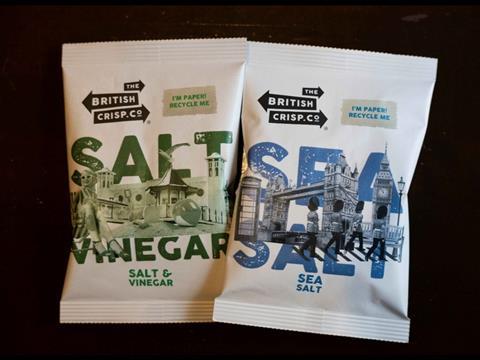
The British Crisp Co. claims to have released the ‘first’ fully kerbside-recyclable paper crisp packet in the UK, intended to counteract eight billion annual crisp packets ending up in landfill or incineration.
Aquapak’s Hydropol polymer – a solution reported to be recyclable, repulpable, compostable in marine environments, and compatible with anaerobic digestion – has been used to laminate the packet. When laminated or extrusion coated onto paper, the polymer is said to add strength and barriers to oxygen, oil, and grease.
If Hydropol ends up in the environment, its reported non-toxic and water-soluble properties are thought to ensure an environmentally safe breakdown, resulting in zero microplastic leakage. Its solubility in water is also expected to unlock 100% paper fibre recovery in paper recycling mills.
A ‘very thin’ layer of vacuum-deposited aluminium is implemented into the crisp packets to keep the product fresh, but it is not thought to impact their recyclability. OPRL has certified the packs as recyclable, meaning they are compatible with consumer kerbside collection streams alongside other paper material.
“Brits consume over eight billion packets of crisps each year, the majority of which are not recyclable and end up in landfill or incinerators – that’s a lot of waste and a huge environmental problem,” said Tom Lock, CEO of British Snack Company. “In partnership with Evopak and using exciting new polymer technology, we have created the first fully recyclable crisp packet – something that consumers have been demanding for a long time.”
Mark Lapping, chief executive officer at Aquapak, continued: “Today’s launch marks a significant milestone for Aquapak and our Hydropol technology, which can be commercialised at scale. This is a huge opportunity for brands and producers who now have a viable, functional and recyclable alternative that enables full fibre recovery in a standard paper recycling process.”
“We have developed a unique paper which has the potential to revolutionise packaging as we know it, thanks to the unique properties of Hydropol,” added Daniel McAlister, director of Business Operations at Evopak. “The paper can be used in a range of applications from snacks and confectionary, to petcare and dry foods and cereals, and costs the same as existing materials.”
Hydropol is thought to match the functionality and performance of conventional plastics while enhancing its recyclability and cutting down on plastic pollution. Its other applications include reusable, heat-sealable paper mailing bags.
Back in 2022, TIPA incorporated Hydropol into its efforts to develop high-barrier, PVDC-free, compostable packaging films – creating new, cost-effective designs that improve both packaging performance and its end-of-life.
Meanwhile, Parkside recently utilized its Park2Nature certified home compostable laminate to provide food and drink brand SMUG with a ‘100% compostable’ crisp packet, apparently biodegrading in domestic compost heaps in under 26 weeks.
Most recently, INEOS Olefins & Polymers Europe, PepsiCo, Amcor, and others joined forces to package Sunbites crisps in new film packaging containing 50% chemically recycled plastic. It forms part of the PepsiCo Positive (pep+) end-to-end transformation, which aspires to cut all virgin fossil-based plastic in crisp and chip bags from PepsiCo’s European supply chain by 2030.
If you liked this story, you might also enjoy:
Report: The ultimate guide to global plastic sustainability regulation
The Brief: Oxo-(bio)degradables: the who, what, and why of breaking down fossil-based plastics
Sustainable Packaging Summit: How Kraft-Heinz uses collaboration to drive innovation
The Brief: Using ocean-bound plastic in packaging – how, why and should we?












No comments yet